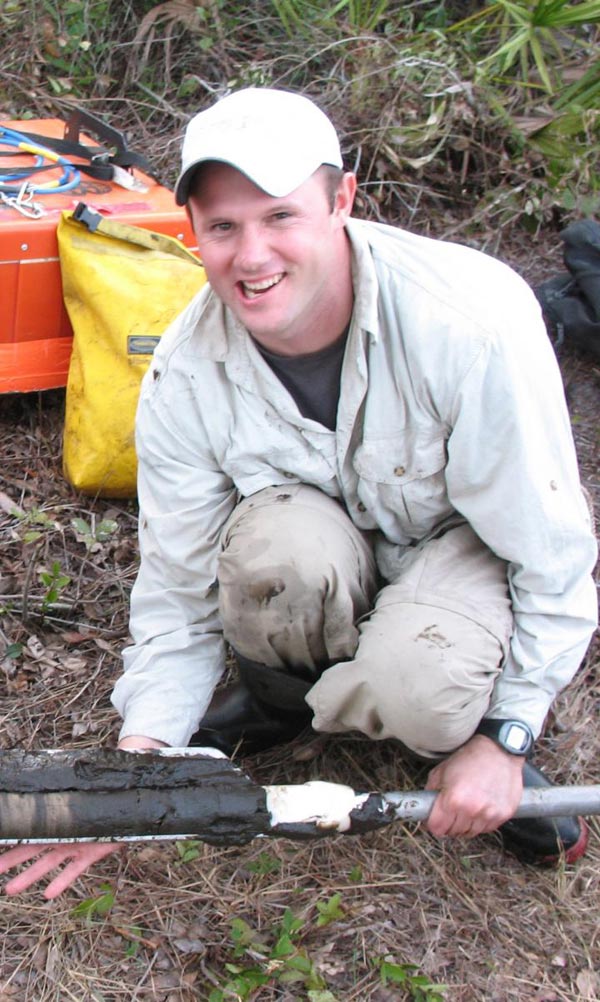Monster hurricanes hit northeast in past warm ocean periods like those in our future

UMass Amherst's Woodruff, an expert in coastal sediment, examined deposits from Salt Pond near Falmouth on Cape Cod. Over hundreds of years, strong hurricanes have deposited sediment into the pond. They extracted 30-foot (nine-meter) sediment cores for laboratory analyses similar to tree-ring dating to establish when intense hurricanes occurred. Credit: UMass Amherst
Scientists today released evidence of historically unprecedented hurricane activity along the northeast coast of what would become the United States between about 800 to 1700 years ago, which was associated with warmer ocean temperatures similar to levels we may expect in coming centuries with climate change and ocean warming.
Geoscientists at the University of Massachusetts Amherst and Woods Hole Oceanographic Institute (WHOI) say new evidence they analyzed in sediment deposits from Cape Cod show that intense hurricanes, possibly more powerful than any storms New England has experienced in recorded history, frequently pounded the region from around 250 A.D. to about 1150.
Jon Woodruff and WHOI researcher Dana MacDonald, currently a visiting scholar at UMass Amherst, with lead author Jeff Donnelly of WHOI, say a warmer climate was associated with more intensity and frequent hurricanes on the U.S. East and Gulf coasts hundreds of years ago. They present a new record of sediment deposits in the current issue of Earth's Future, a journal of the American Geophysical Union.
Woodruff, MacDonald, Donnelly and colleagues report that 23 severe hurricanes hit the New England area between the years 250 A.D. and 1150, the equivalent of a severe storm on average about once every 40 years. Many were likely category 3 storms like Hurricane Katrina or category 4 storms like Hugo that would be catastrophic if they hit the region today, the authors add.
The study, the first to find evidence of historically unprecedented hurricane activity along the northeast coast, extends the hurricane record for the region by hundreds of years. Donnelly says the historical interval was “unlike what we've seen in the last few hundred years.”
UMass Amherst's Woodruff, an expert in coastal sediment, with paleo-ecologist MacDonald and colleagues examined deposits from Salt Pond near Falmouth on Cape Cod. The pond is separated from the ocean by a 4.3- to 5.9-foot (1.3- to 1.8-meter) sand barrier. Over hundreds of years, strong hurricanes have deposited sediment over the barrier and into the pond where it has remained undisturbed. They extracted 30-foot (nine-meter) sediment cores for laboratory analyses similar to tree-ring dating to establish when intense hurricanes occurred.
Woodruff says, “The study shows that our region has been prone to storms of far greater magnitude than those impacting the area over the past century. With so many more people, structures, roads and bridges in place now, we should begin to design and plan for these higher-magnitude events.”
MacDonald, who developed a high resolution pollen diagram to help date the core as the sedimentary records moved from the pre-Colonial period before about 1670 into the early and later periods of western settlement, says, “The study integrated the work of a diverse group of authors and combines a large number of hurricane reconstructions developed over the years by this group and others. The results are a comprehensive synthesis that provides insight on how major climate-forcing mechanisms influence both broad-scale Atlantic basin and regional northeastern Atlantic hurricane activity.”
The researchers report finding evidence of 32 hurricanes overall, plus the remains of three storms that occurred in 1991, 1675 and 1635. Sediments showed two periods of elevated intense hurricane activity on Cape Cod, from 150 to 1150 and 1400 to 1675.
The earlier period of powerful hurricane activity matched previous studies that found evidence of high hurricane activity during the same period in more southerly areas of the western North Atlantic Ocean basin from the Caribbean to the Gulf Coast. The new data suggest that many powerful storms spawned in the tropical Atlantic Ocean between 250 and 1150 also battered the U.S. East Coast.
High hurricane activity continued in the Caribbean and Gulf of Mexico until 1400, although there was a lull in hurricane activity during this time in New England, they add. A shift in hurricane activity in the North Atlantic occurred around 1400 when activity picked up from the Bahamas to New England until about 1675.
Specifically, MacDonald explains, “The large changes in the pollen reflecting clearing of the landscape and the introduction of European agricultural plants helped identify age way-points along with other dating techniques, to clearly identify hurricanes recorded in western records, especially the Colonial storms of 1635 and 1675.”
Donnelly says, “We hope this study broadens our sense of what is possible and what we should expect in a warmer climate. We may need to begin planning for a category 3 hurricane landfall every decade or so rather than every 100 or 200 years. The risk may be much greater than we anticipated.”
Media Contact
All latest news from the category: Earth Sciences
Earth Sciences (also referred to as Geosciences), which deals with basic issues surrounding our planet, plays a vital role in the area of energy and raw materials supply.
Earth Sciences comprises subjects such as geology, geography, geological informatics, paleontology, mineralogy, petrography, crystallography, geophysics, geodesy, glaciology, cartography, photogrammetry, meteorology and seismology, early-warning systems, earthquake research and polar research.
Newest articles

A ‘language’ for ML models to predict nanopore properties
A large number of 2D materials like graphene can have nanopores – small holes formed by missing atoms through which foreign substances can pass. The properties of these nanopores dictate many…

Clinically validated, wearable ultrasound patch
… for continuous blood pressure monitoring. A team of researchers at the University of California San Diego has developed a new and improved wearable ultrasound patch for continuous and noninvasive…

A new puzzle piece for string theory research
Dr. Ksenia Fedosova from the Cluster of Excellence Mathematics Münster, along with an international research team, has proven a conjecture in string theory that physicists had proposed regarding certain equations….



